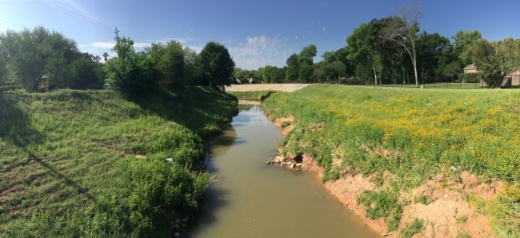Two flood-control projects in the city of Jersey Village are moving forward after city council members unanimously approved two contracts at a Feb. 22 meeting.
The projects—which have been part of city plans since the city adopted a long-range flood plan in 2017—include a four-foot earthen barrier that will be built around the Jersey Meadow Golf Course at a cost of $1.3 million and a series of drainage improvements on some of the city's most flood prone streets—Wall, Crawford, Carlsbad and Tahoe streets as well as Capri Drive—at the cost of $5.7 million. The city is contracting with SER Construction Partners on the drainage project and with Greenscapes Six LLC on the golf course project.
When combined, the two projects will reduce damages from a 100-year storm by $757,580, according to city estimates.
City Manager Austin Bleess said the projects will be largely funded by grant money, including a $3.7 million grant from the Federal Emergency Management Agency, a $921,000 grant from the Texas Infrastructure Resiliency Fund and $1.8 million in Community Development Block Grants from the Texas Governor's Land Office.
Because the projects are closely related in terms of the benefits, they were rolled together for the grant process. The city will pay about $600,000, Bleess said.
"We've worked on this project for a really, really long time and have gone back and forth about it," Jersey Village Mayor Andrew Mitcham said at the Feb. 22 meeting. "The fact that we’re doing this right now is going to bring a lot of relief to a lot of people who get as big of a heartburn as I do when a storm is headed our way."
Both projects are expected to take 300 days to complete starting from when the contract is officially signed, said Jim Cartwright, senior project manager with Brooks and Sparks, the consulting engineering firm that helped the city through the bidding process. The projects will be underway at the same time Harris County works to
widen White Oak Bayou, including a stretch that runs through Jersey Village.
Bleess said work on the golf course berm should not interfere with use of the course, and the end product will blend in with the course's natural appearance. The barrier—or berm—will function by holding water during heavy rains upstream of a White Oak Bayou channel that runs through the city, Cartwright said. It will also work in a complementary fashion with the drainage project to keep water from flooding the Wall Street subdivision nearby.
"You have the benefit of, when
the channel downstream has the capacity, the water will gravity out, but when the water backs up, we have flap gates that will close off and it will prevent the water from the channel from running into the [Wall Street] neighborhood," Cartwright said.
Mitcham acknowledged the long wait between the Tax Day Floods of 2016—which served as a catalyst that drove the city to pursue the flood-control projects—and the signing of the contracts. However, he said he believed the city approached the issue in the right way.
"This was not the fastest way, but it was definitely the correct way, the most fiscally responsible way [and] the best way to share this burden among everyone in the most fair way," he said.





